After originally agreeing to join EPL club Watford on a five-year deal earlier this year following the conclusion of the 2019/20 campaign in France, Pape Gueye made headlines when he extraordinarily walked back his decision to join the Hornets, despite his signing already being announced by the English club via their official Twitter account.
Instead, following his departure from Le Havre, Gueye has joined Ligue 1’s runners up for the 2019/20 season, Olympique de Marseille. The 21-year-old midfielder is a product of the famed academy of Le Havre, which has produced talents such as Paul Pogba, Ferland Mendy, Benjamin Mendy, as well as Gueye’s new teammates Steve Mandanda and Dimitri Payet, down the years.
In this tactical analysis, in the form of a scout report, we will examine how Gueye performed for Le Havre last season. This tactical analysis will look at how the midfielder was utilised within Paul Le Guen’s tactics for the Ligue 2 side last season and we will attempt to explain how he may fit into André Villas-Boas’ Marseille tactics this coming season.
Positioning
Le Havre primarily lined up in a 4-4-2 shape during the 2019/20 campaign and Gueye typically occupied one of the two central midfield slots, usually the left-sided central midfield position, within that shape.
Le club doyen used the 4-4-2 in 30% of their Ligue 2 games which was more often than they lined up in any other shape, however, they did utilise a variety of different formations throughout the campaign, including a 4-3-3 which they used 10% of the time, making that their second-most frequently used formation.
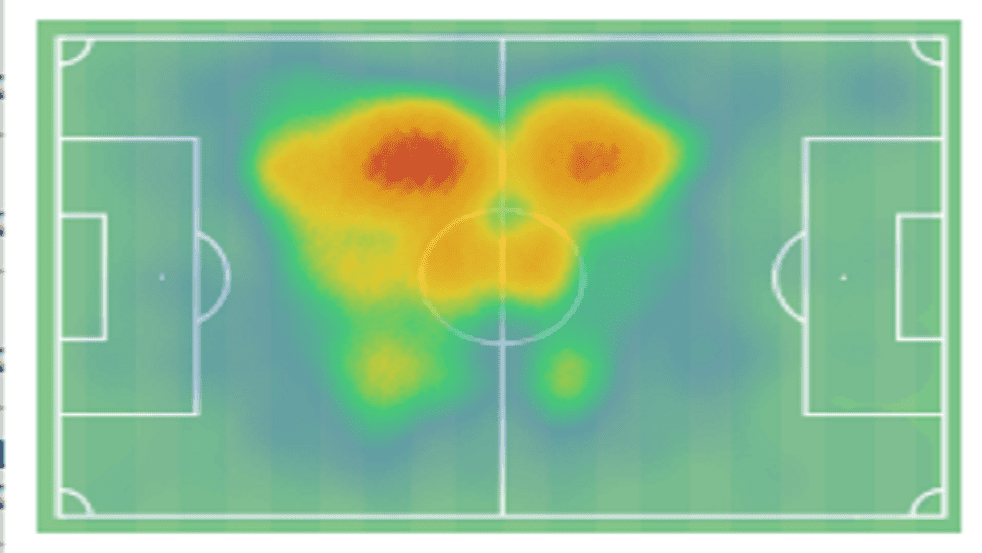
The above image is Gueye’s heatmap for the 2019/20 Ligue 2 season. This shows us that he primarily played on the left side of central midfield, spending the majority of his time in a deeper area of the pitch, which is marked red on this map, however, we can see that he also ventured into the opposition’s half of the pitch frequently. However, he rarely probed too far into the final third.
Gueye is comfortable at playing a box-to-box role and he possesses enough quality in a variety of different areas of his game that allow him to do so effectively. As we will touch on later on in this tactical analysis, he is comfortable on the ball and his technical ability can come in handy for his team when he is utilised in a deeper role in possession or when he is situated higher up the pitch during a period of possession.
Meanwhile, he is an aggressive defender and he is comfortable with defending high up the pitch or in deeper areas, as he often had to do last season with Le Havre who had a PPDA (opposition passes allowed per defensive action) of 11.7, which was lower than just six other Ligue 2 teams and was slightly higher than the league average, indicating that they didn’t tend to defend so aggressively high up the pitch.
However, Gueye has played the central, holding midfield role more often than any other role thus far during his young career and it may be fair to say that this is his natural and most comfortable role, particularly in possession of the ball.
This may be a positive for him joining Marseille, as Les Olympiens generally utilised a sole holding midfielder in their team last season, lining up in a 4-1-4-1 shape in 45.9% of their league fixtures.
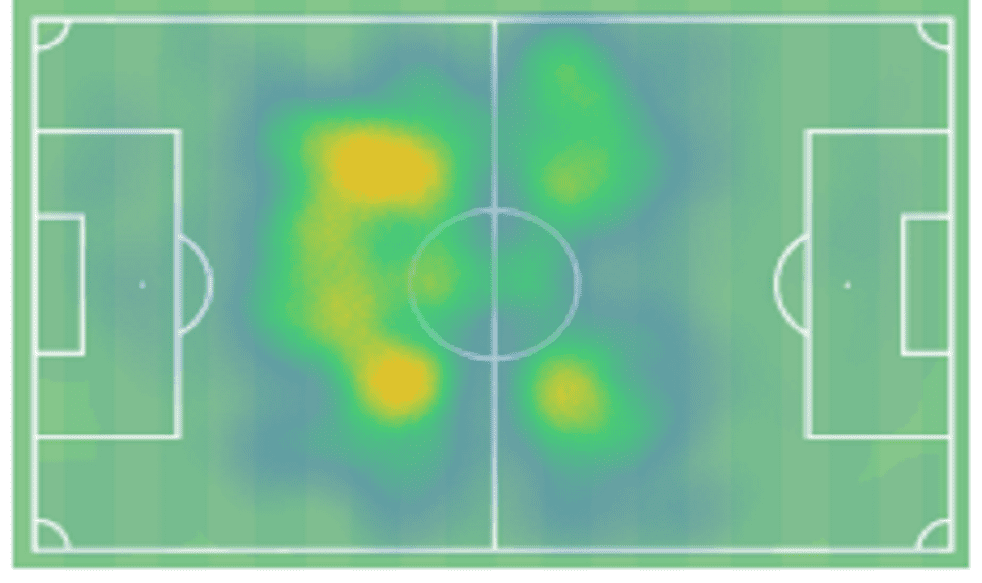
Kevin Strootman occupied this position more often than any other player for Marseille last season and the Dutchman’s heatmap for the 2019/20 Ligue 1 campaign can be seen in the image above.
In addition to the central position, this image shows us that Strootman spent plenty of time slightly off-centre, particularly towards the left side of the pitch, which is a position that Gueye enjoyed occupying last season.
Within Marseille’s tactics and their 4-1-4-1 shape, the two ‘8’s in their midfield generally play quite attacking roles, occupying the half-spaces and pushing out into wide areas during periods of possession and considering that Gueye doesn’t tend to venture too far into the final third, it may be unlikely that he will occupy one of these two positions. Therefore, it may be reasonable to assume that the 21-year-old will primarily play in the holding midfield position for Marseille next season and he may be seen as the eventual successor to Strootman, who is nine years his senior having turned 30 years old in February.
With that in mind, we will continue to compare and contrast Gueye with the Dutchman where appropriate throughout this scout report.
Ball progression
Le Havre weren’t a heavily possession-based side last season, keeping an average of just 48% possession in Ligue 2. Gueye was valuable for them and their tactics during the 2019/20 campaign because he is good at progressing the ball up the pitch. Gueye’s long-ball-playing ability and his effectiveness at sending the ball up into the final third from the midfield were key in helping the relatively direct Le Havre to create chances.
Gueye didn’t typically play the role of the ‘creator’ or the one to play that final ball, as is evident by the fact that he made just two league assists last season. However, he was good at finding those types of players in good positions where they could then create goalscoring opportunities.
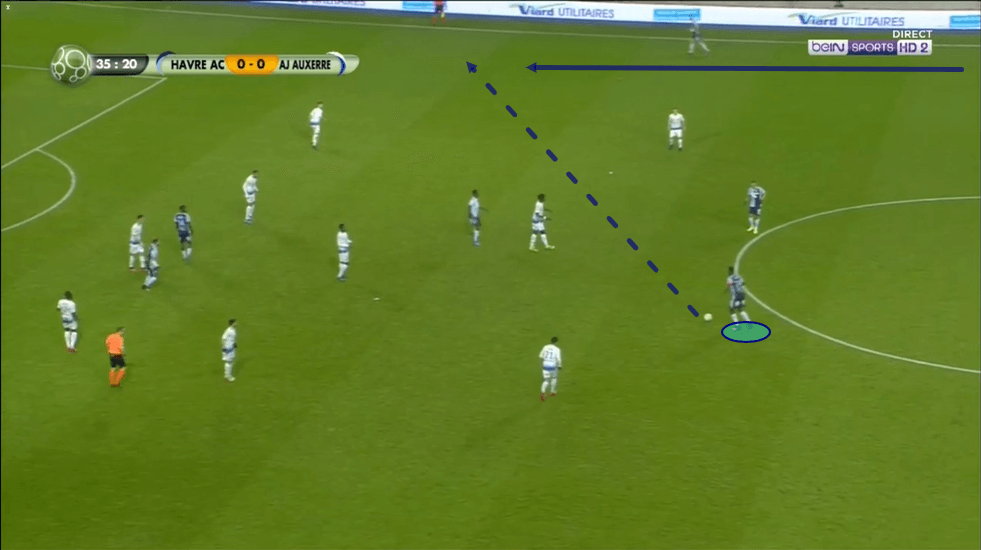
One of the ways Gueye did this was by frequently playing long-balls. The midfielder played an average of 6.71 long-balls per league game during the 2019/20 campaign, which is more than every other outfield Le Havre player. This is also more long-balls than any Marseille player played per league game last season, though Les Olympiens also differed from Le Havre stylistically and were generally a more possession-based side. We can see an example of the kind of situation that Gueye typically found himself in to play long-balls last season in the image above.
Here, we can see that the 21-year-old is positioned just inside of the opposition’s half of the pitch, however he is not in an incredibly advanced position at this moment. Nevertheless, he enjoys plenty of time and space on the ball as no opposition players press him particularly aggressively and this allows him to pick out the overlapping right-back with a long-ball.
In addition to playing the most long-balls of any outfield Le Havre player last season, Gueye also had a long-ball completion rate of 59.65% during the 2019/20 Ligue 2 campaign, which was higher than Le Havre’s average of 54.9% and Marseille’s average of 58%.
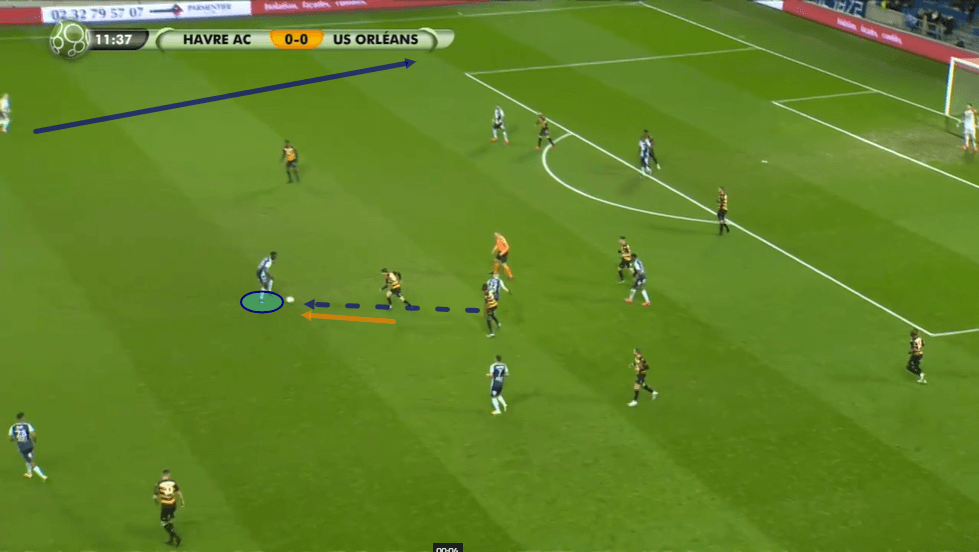
This next image shows us an example of Gueye receiving the ball slightly higher up the pitch, though still situated behind many of his teammates. We can see that as he prepares to receive possession here, he is being put under pressure by an opposition player who is quite close in proximity to him at this moment.
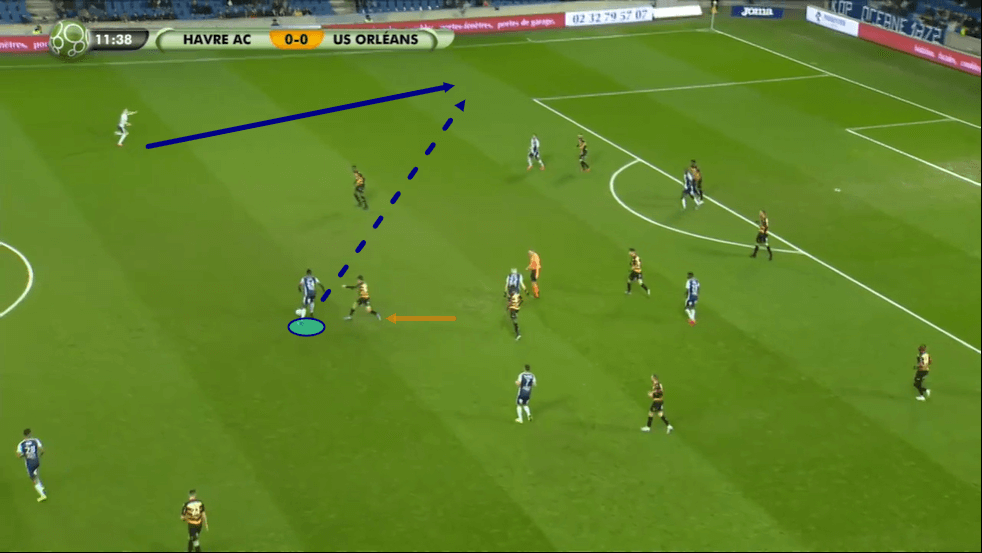
As this passage of play moves on, we see that Gueye remains calm and deals well with the pressure being applied to him. He takes the ball well, smoothly rotating his body while controlling the ball to place himself in between it and the nearest opposition player. He also exhibits his impressive range of vision and fast-thinking here and as soon as he controls the ball and turns, he spreads the play with a long-ball, sending the overlapping left-back into space.
This passage of play highlights a couple of key areas of Gueye’s game. Firstly, we can see how relaxed he tends to remain on the ball despite pressure being applied to him by this opposition player. Gueye’s composed nature on the ball may play a part in him maintaining an above-average long-ball success percentage, despite playing so many of them. Additionally, this passage of play shows us how good Gueye is at receiving the ball well.
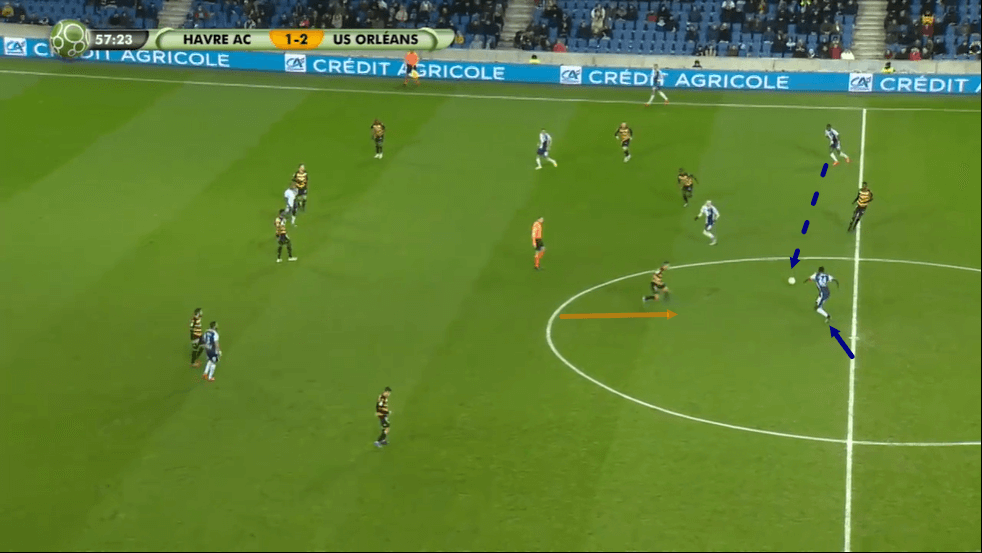
Receiving the ball is an art in and of itself and furthermore, it is one that Gueye shows that he is proficient at during the 2019/20 season. The image above shows us an example of the midfielder occupying his deep, central position in front of the centre-backs and behind the other midfielders and attackers.
As the Frenchman prepares to receive possession here, he is put under pressure, once again, by an opposition player, however, Gueye remains calm in this situation too and after running towards the ball to get into position to receive it, he faints and allows the ball to roll across him before controlling it with the inside of his left foot.
By receiving the ball like this, Gueye allowed himself to make use of a greater, more full view of the pitch, as opposed to if he had just ran straight on to control this ball and potentially put himself in a high-pressure situation without many progressive passing options available to him.
As play moves on, he spread the ball out to the left-wing and found an overlapping left-back.
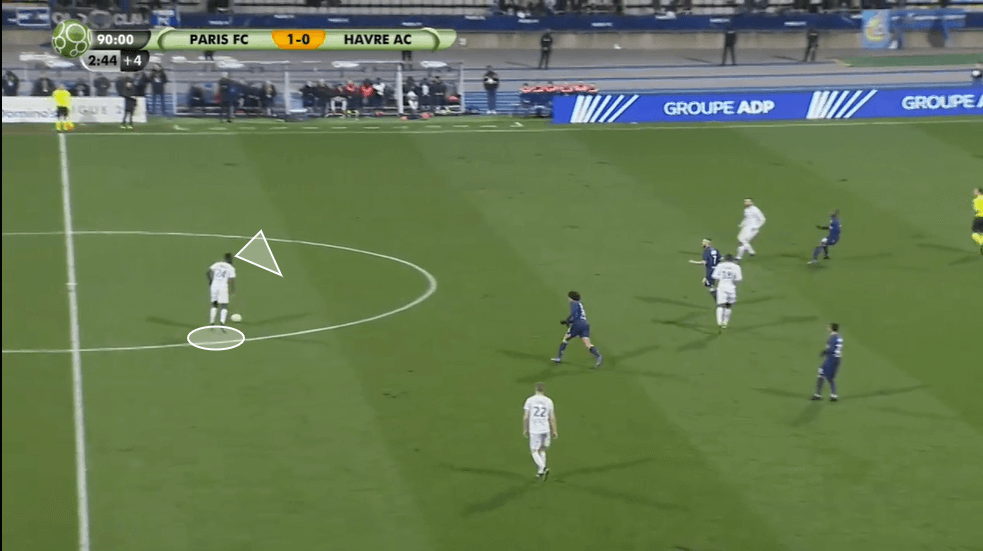
Gueye thrives in this deep position, such as the one we can see him in here, because when he receives the ball in this position, he possesses the technical passing ability to find his teammates via a long-ball and if playing versus a deep, compact, narrow defence, this can help his side to stretch the play and potentially create an opening in that defence.
Meanwhile, we’ve seen that if he is pressed, he generally possesses enough composure and, again, technical ability to deal with the high-pressure situation while retaining possession. This may be good news for Marseille fans and it appears as though Gueye could potentially offer his new side some quality on the ball in the holding midfield position.
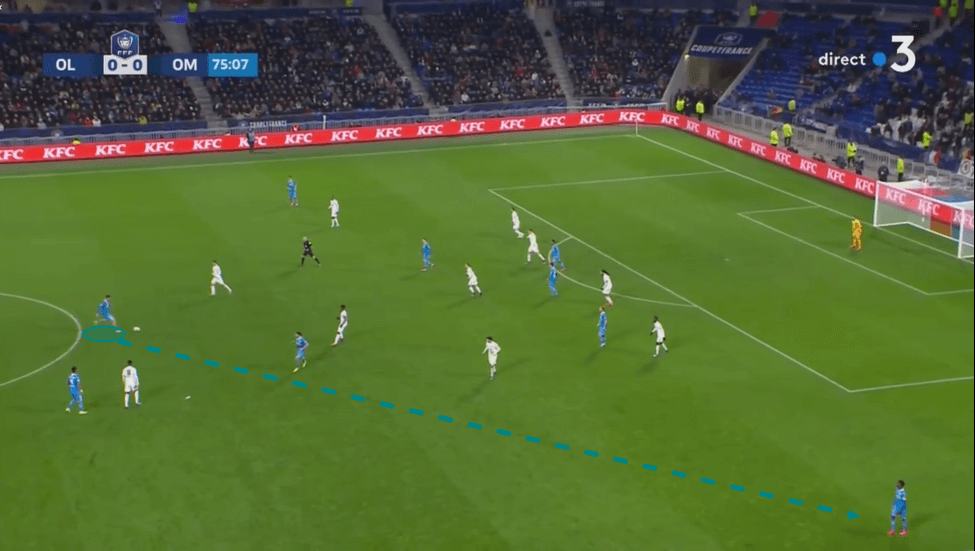
This image above shows us an example of Marseille’s Strootman operating in a similar fashion to Gueye last season. Like the 21-year-old Frenchman, Strootman tends to play at the base of his side’s midfield and he too is tasked with stretching the play and finding wide teammates via long-balls, although he did do so less often and with less accuracy than the ex-Le Havre man.
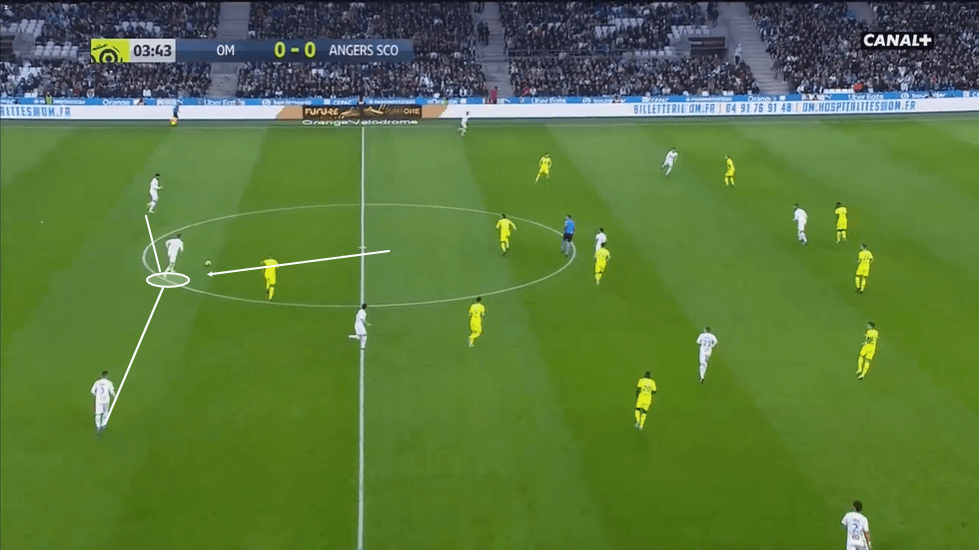
Similarly, this image above shows us another example of the Dutch Marseille man occupying a deep position within Villas-Boas’ tactics. If given the opportunity to perform this role next season, we believe that Gueye’s long-ball-playing ability and composure on the ball will help to make him a useful option for Les Olympiens during the 2020/21 campaign.
Tackling
On the ball, as a holding midfielder, Gueye offered his side plenty by way of creativity last season, however, in addition to building attacks, the Frenchman also demonstrated that he enjoyed breaking up opposition attacks during the 2019/20 campaign.
While he liked to sit in front of the defence in possession and he did well playing the role of the deep-lying playmaker who can dictate play from deep, out of possession, Gueye was at his best when given license to hunt down the ball and press aggressively last season.
In addition to being quite press resistant in possession, Gueye showed that he could apply pressure in advanced areas of the pitch in order to win back possession as well.
In general, as we previously mentioned, Le Havre didn’t tend to hunt for the ball particularly aggressively last season, however, Gueye was quite suited to the system when it was what Le Havre were going for.
The fact that he usually operated in a two-man midfield last season may have benefitted him in this manner and potentially gave him some license to depart from his natural position and press the opposition aggressively, as he had the security of an extra man behind him, in his central midfield partner.
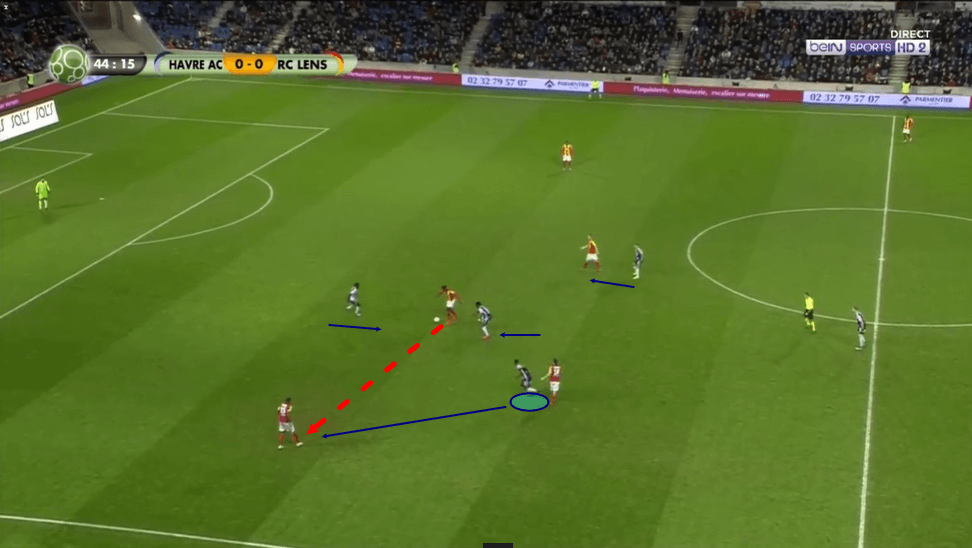
In this image above, we can see Le Havre’s opponents attempting to play out from the back. Gueye, circled here, is playing in his left central midfield position here, however, as the ball-carrier begins to aim his pass out to the full-back, Gueye leaves the opposition player that he is marking and begins to rush towards the full-back, while keeping that midfielder in his cover shadow in order to ensure that this passing angle was cut off and it would be difficult for the full-back to get past him.
As this passage of play moves on, we see that Gueye’s press pays off for Le Havre and he manages to cut off the simple passing lane into midfield, ultimately forcing the full-back to try and go long. Gueye intercepts this pass and forces a turnover in a dangerous area of the pitch as a result.
In addition to a high level of anticipation, Gueye’s speed plays a big role in his effectiveness as a ball-winner. As we saw in this most recent passage of play, the midfielder was able to pounce as soon as the pass was played from the central player out to the full-back. His speed combined with his anticipation to help him to close the gap between himself and the full-back quickly and ultimately go on to force a turnover inside the opposition’s half of the pitch.
Gueye made an average of 10.13 recoveries per league game last season, with 35.3% of them coming inside the opposition half of the pitch. Meanwhile, Strootman made an average of 8.77 recoveries per league game last term, with 37.5% of them coming inside the opposition’s half of the pitch.
It may be fair to say that, These stats are similar and Gueye’s number of recoveries and the percentage of them that came in the opposition’s half of the pitch may be encouraging for a Marseille side who had the third-lowest PPDA of any Ligue 1 side last season. This indicates that Les Olympiens were one of the most aggressive sides at winning the ball back high up the pitch last season.
Marseille’s defensive style may suit Gueye, with that in mind. Considering that his number of recoveries stack up well when compared with Strootman’s for the 2019/20 season despite the fact that the Frenchman played in a less aggressive side and in a weaker league, it will be interesting to see how Gueye adapts to Marseille on the defensive side of things this coming season.
One area that 21-year-old Gueye may have an advantage over 30-year-old Strootman is speed and mobility. We touched on Gueye’s speed earlier on in this particular section of analysis. The Frenchman is very quick and mobile, which provides a contrast to Strootman.
The Dutchman does attempt to press high up the pitch, however, it may be fair to say that some weaknesses in this side of his game have been exposed at times this season.
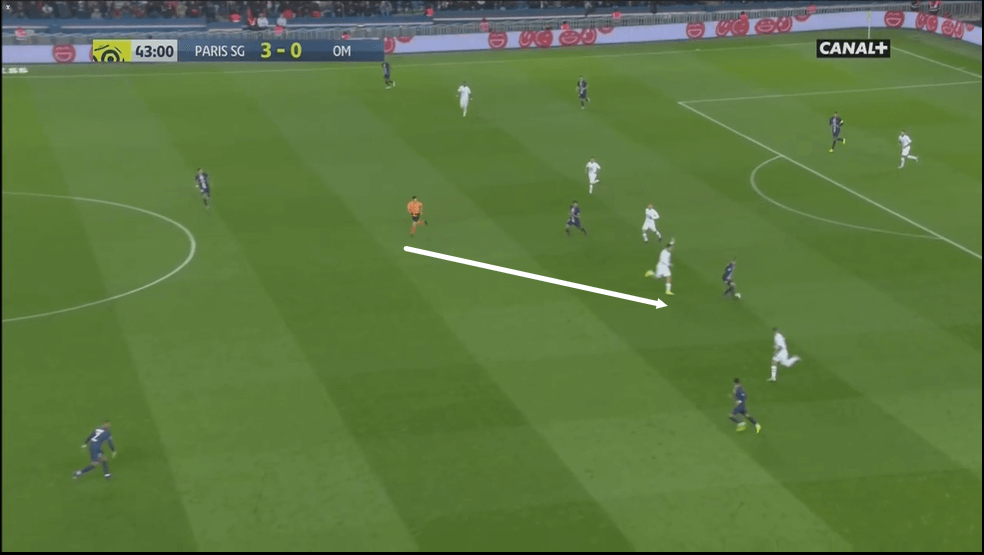
The image above provides us with an example of Strootman pressing an opposition player quite aggressively while they attempt to build-out from the back. We can see the midfielder angling his run to try and cut off the player where he thinks he will be exiting and we can see that he is quite committed to this challenge because he is approaching the opposition player at a fairly high speed here.
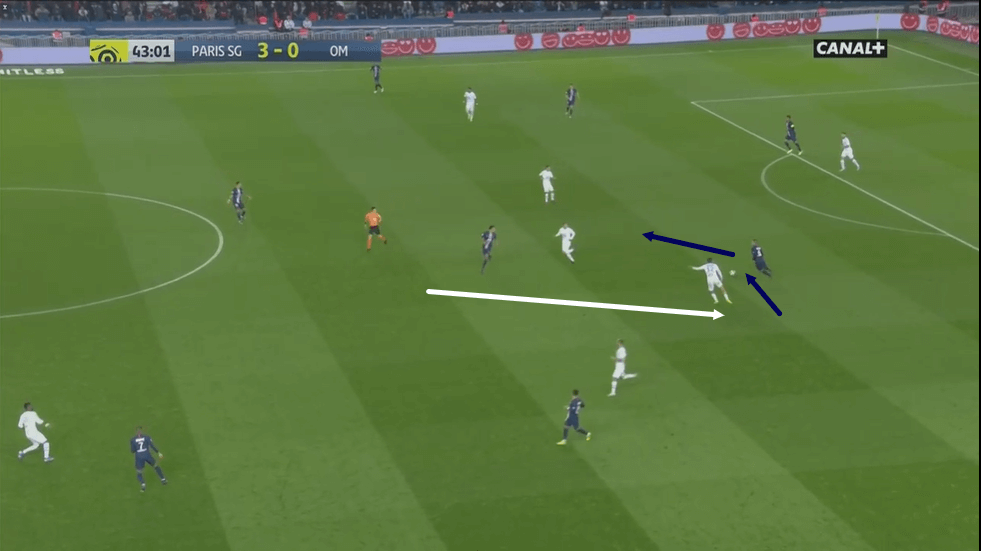
As play moves on, we see that the deep opposition player was able to shake off the pressure from Strootman by simply making a quick change of direction on the ball. This little movement threw Strootman off and allowed the opposition player to build pas him and the rest of this line of Marseille pressure.
Gueye is more mobile, quick, and agile than Strootman and with that in mind, he could offer an improvement for his new club in terms of ball recovery if he can adapt quickly to life in Ligue 1 and carry over the form that left him so highly sought-after at the end of last season.
Interceptions
In addition to tackling, Gueye’s speed also plays an important role in helping the midfielder to make interceptions. The 21-year old made 5.14 interceptions per league game during the 2019/20 campaign, which is more interceptions than any Marseille player other than Jordan Amavi made last season.
Again, stylistic differences between Les Olympiens and Le Havre may undoubtedly have played a big role in that, however, while Marseille finished in second place on the league table last season, they finished in sixth place on the ‘goals conceded’ table and so it may be fair to say that the club could make some defensive improvements and Gueye’s impressive defensive statistics may have made him an attractive prospect for Marseille prior to joining the club.
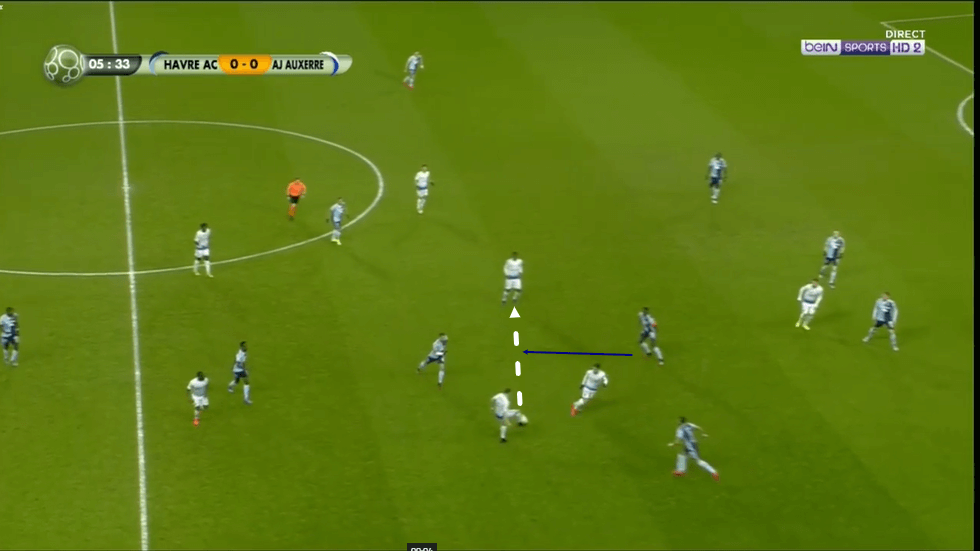
This image above provides us with an example of the importance of Gueye’s anticipation and speed when it comes to making interceptions. Here, we can see the midfielder positioned in his left-sided central midfield position, just reacting as the opposition wide man plays a pass into the central player.
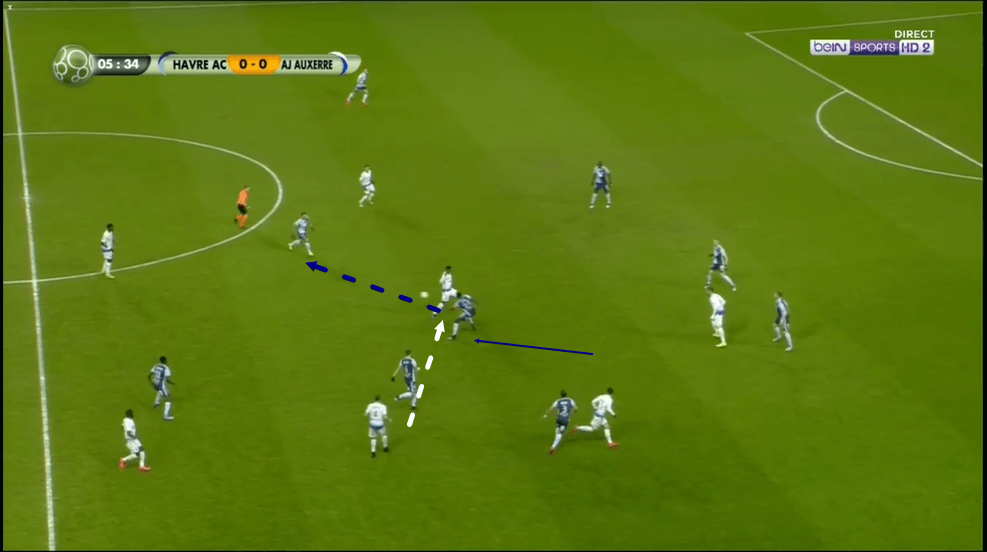
As play moves on, and just a second later, Gueye manages to get a foot on the pass that was played by the wide man into the central player, thanks to his speed and ability to read the game. He subsequently flicks the ball into the direction of a teammate, in an attempt to kickstart a counterattack.
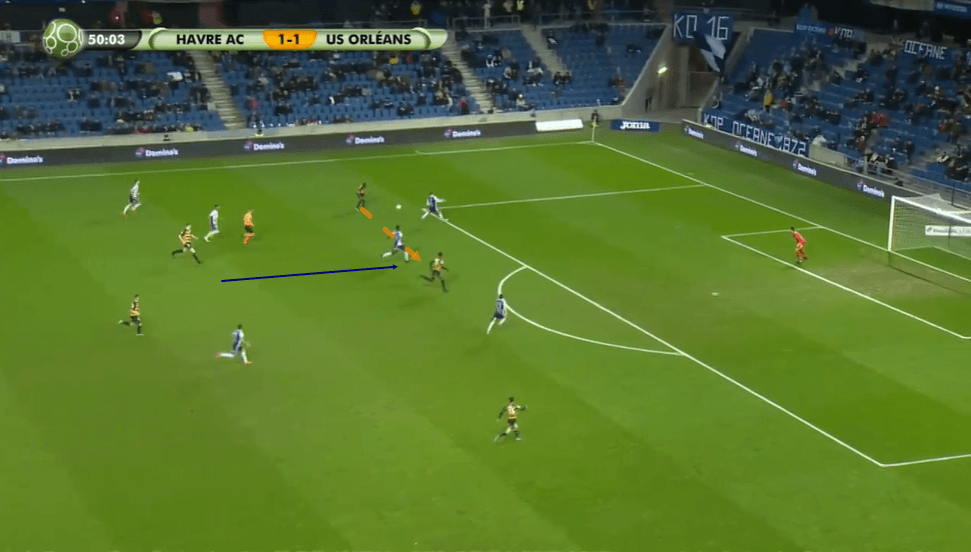
Additionally, Gueye’s speed and anticipation also helps him to make interceptions and perform effectively in deeper areas of the pitch. The midfielder can be seen tracking back and attempting to get himself in between the winger and the centre forward while defending against a counterattack, here.
His pace helped him to make up quite a bit of ground that allowed him to cut off this opposition pass in a dangerous area of the pitch. This image shows us how effective the 21-year-old can be when operating in the deeper, central area off the ball. While Gueye does like roaming around and trying to take back possession for his side in advanced areas of the pitch, he can also put the same anticipation and physical skills that come in handy when defending high up the pitch, to use when defending deep.
This image shows us an example of how Gueye’s speed and mobility will be useful for his side in terms of putting a stop to opposition counterattacks, as the 21-year-old could be more useful than Strootman in those situations thanks to his quickness and mobility which help him to get back and make last-ditch interceptions like this one.
At 189cm (6’2”) tall, Gueye stands at a decent height for a midfielder and this height helps him to win aerial duels and make aerial interceptions. The 21-year-old displayed plenty of enthusiasm and aggression off the ball to get himself in between opposition players and intercept their passes last season. He likes to contest aerial duels and is effective in those situations thanks to his size. He has shown himself to be happy to roam around the midfield not just in order to hunt down the ball on the ground, but also to battle for it in the air.
Conclusion
To conclude this scout report providing a tactical analysis of how Gueye may fit into Marseille’s tactics this coming season, we believe that the 21-year-old midfielder has shown plenty of ability both on and off the ball that could translate well to Villas-Boas’ side.
Gueye is very good at progressing the ball and his long-ball playing ability may be his standout trait in possession. Meanwhile, he is quick, mobile, aggressive, and he possesses intelligent anticipation off the ball.
All of these traits combined to help Gueye be a standout midfielder in Ligue 2 last season and now he will have the opportunity to learn from and compete with Strootman at UEFA Champions League club Marseille. We believe that he and the Dutchman share a variety of stylistic similarities and Gueye could be lined up as the 30-year-old’s eventual successor in Les Olympiens’ midfield.





Comments